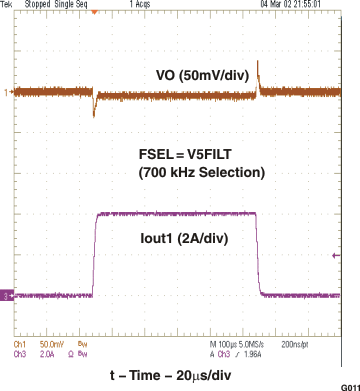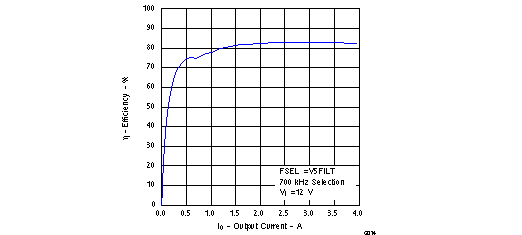SLVS887C April 2009 – August 2014 TPS53114
PRODUCTION DATA.
- 1 Features
- 2 Applications
- 3 Description
- 4 Simplified Schematics
- 5 Revision History
- 6 Pin Configurations and Functions
- 7 Specifications
-
8 Detailed Description
- 8.1 Overview
- 8.2 Functional Block Diagram
- 8.3
Feature Description
- 8.3.1 PWM Operation
- 8.3.2 Drivers
- 8.3.3 PWM Frequency and Adaptive On-time Control
- 8.3.4 5-Volt Regulator
- 8.3.5 Soft Start
- 8.3.6 Pre-bias Support
- 8.3.7 Switching Frequency Selection
- 8.3.8 Output Discharge Control
- 8.3.9 Over Current Protection
- 8.3.10 Over/under Voltage Protection
- 8.3.11 UVLO Protection
- 8.3.12 Thermal Shutdown
- 8.4 Device Functional Modes
-
9 Application and Implementation
- 9.1 Application Information
- 9.2
350-kHz Operation Application
- 9.2.1 Design Requirements
- 9.2.2
Detailed Design Procedure
- 9.2.2.1 Choose Inductor
- 9.2.2.2 Choose Output Capacitor
- 9.2.2.3 Choose Input Capacitor
- 9.2.2.4 Choose Bootstrap Capacitor
- 9.2.2.5 Choose VREG5 and V5FILT Capacitors
- 9.2.2.6 Choose Output Voltage Set Point Resistors
- 9.2.2.7 Choose Over Current Set Point Resistor From: IOCL + To: IOCL - minus VOCLoff
- 9.2.2.8 Choose Soft Start Capacitor
- 9.2.2.9 Choose Package Option
- 9.2.3 350 kHz Application Curves
- 9.3 700 kHz Operation Application
- 10Power Supply Recommendations
- 11Layout
- 12Device and Documentation Support
- 13Mechanical, Packaging, and Orderable Information
封装选项
机械数据 (封装 | 引脚)
散热焊盘机械数据 (封装 | 引脚)
- PWP|16
订购信息
9 Application and Implementation
9.1 Application Information
9.2 350-kHz Operation Application
The schematic of Figure 12 shows a typical 350-kHz application schematic. The 350 kHz switching frequency is selected by connecting FSEL to the GND pin. The input voltage is 12 V and the output voltage is 1.05 V.
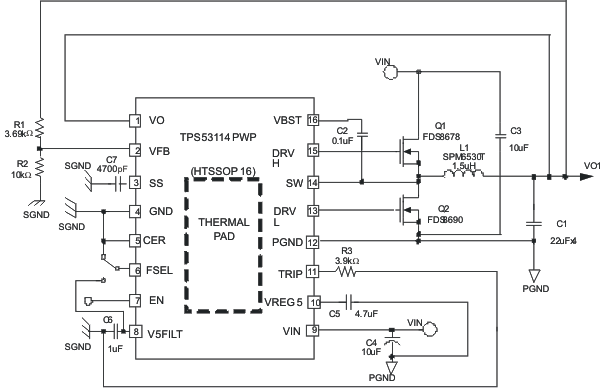 Figure 12. Typical Application Circuit at 350-kHz Switching Frequency Selection (FSEL pin = GND)
Figure 12. Typical Application Circuit at 350-kHz Switching Frequency Selection (FSEL pin = GND)
9.2.1 Design Requirements
Table 1. Design Parameters
| PARAMETERS | EXAMPLE VALUES |
|---|---|
| Input voltage | 12 V |
| Output voltage | 1.05 V |
| Output current | 4 A |
| Switching frequency | 350 kHz |
9.2.2 Detailed Design Procedure
9.2.2.1 Choose Inductor
The inductance value is selected to provide approximately 30% peak to peak ripple current at maximum load. Larger ripple current increases output ripple voltage, improve S/N ratio and contribute to stable operation. L1 can be calculated using Equation 3.

The inductors current ratings needs to support both the RMS (thermal) current and the peak (saturation) current. The RMS and peak inductor current can be estimated as follows:



Note:
The calculation above shall serve as a general reference. To further improve transient response, the output inductance could be reduced further. This needs to be considered along with the selection of the output capacitor.
9.2.2.2 Choose Output Capacitor
The capacitor value and ESR determines the amount of output voltage ripple and load transient response. Recommend to use ceramic output capacitor.


Where:


Select the capacitance value greater than the largest value calculated from Equation 7, Equation 8 and Equation 10. The capacitance for C1 should be greater than 66 μF.
Where:
Δ VOS = The allowable amount of overshoot voltage in load transition
ΔVUS = The allowable amount of undershoot voltage in load transition
Tmin(off) = Minimum off time
9.2.2.3 Choose Input Capacitor
The TPS53114 requires an input decoupling capacitor and a bulk capacitor is needed depending on the application. A minimum 10-μF high-quality ceramic capacitor is recommended for the input capacitor. The capacitor voltage rating needs to be greater than the maximum input voltage.
9.2.2.4 Choose Bootstrap Capacitor
The TPS53114 requires a bootstrap capacitor from SW to VBST to provide the floating supply for the high-side drivers. A minimum 0.1-μF high-quality ceramic capacitor is recommended. The voltage rating should be greater than 10.0 V.
9.2.2.5 Choose VREG5 and V5FILT Capacitors
The TPS53114 requires both the VREG5 regulator and V5FILT input are bypassed. A minimum 4.7-μF high-quality ceramic capacitor must be connected between the VREG5 and GND for proper operation. A minimum 1.0-μF high-quality ceramic capacitor must be connected between the V5FILT and GND for proper operation. Both of these capacitors' voltage ratings should be greater than 10 V.
9.2.2.6 Choose Output Voltage Set Point Resistors
The output voltage is set with a resistor divider from output voltage node to the VFBx pin. It is recommended to use 1% tolerance or better resistors. Select R2 between 10 kΩ and 100 kΩ and use Equation 11 or Equation 12 to calculate R1.


Where:
VFB1(ripple) = Ripple voltage at VFB1
9.2.2.7 Choose Over Current Set Point Resistor


Where:
RDS(ON) = Low side FET on-resistance
ITRIP = TRIP pin source current (≉ 10 μA)
VOCLoff = Minimum over current limit offset voltage (-20 mV)
IOCL = over current limit
9.2.2.8 Choose Soft Start Capacitor
Soft start timing equations are as follows:


9.2.2.9 Choose Package Option
TPS53114 power dissipation:

Where:
CiH = Input capacitor of high side MOSFET
CiL = Input capacitor of low side MOSFET
Choose package considering the Dissipation Rating table.
9.2.3 350 kHz Application Curves
The application curves of Figure 13 and Figure 14 apply to both the circuits of 700 kHz Operation Application and 350-kHz Operation Application.
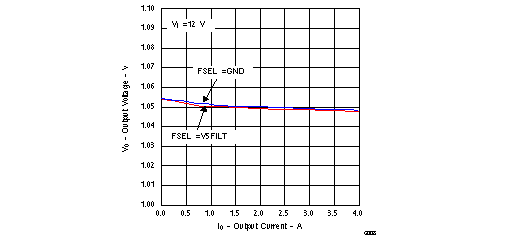
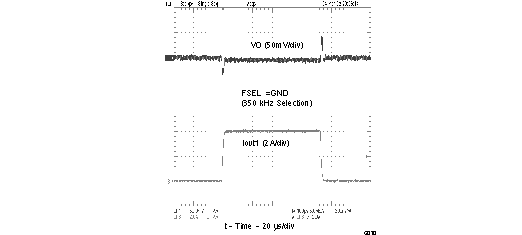
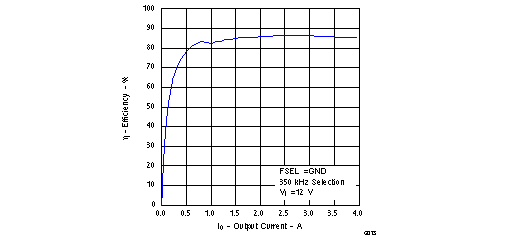
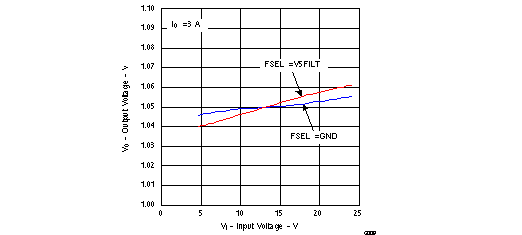
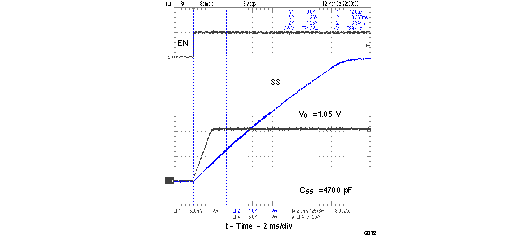
9.3 700 kHz Operation Application
The schematic of Figure 18 shows a typical 700 kHz application schematic. The 700 kHz switching frequency is selected by connecting FSEL to the V5FILT pin. The input voltage is 12 V and the output voltage is 1.05 V.
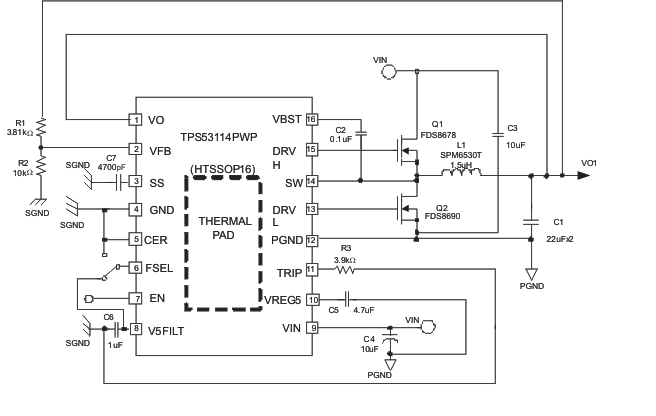 Figure 18. Typical Application Circuit at 700-kHz Switching Frequency Selection (FSEL pin = V5FILT)
Figure 18. Typical Application Circuit at 700-kHz Switching Frequency Selection (FSEL pin = V5FILT)
9.3.1 Design Requirements
Table 2. Design Parameters
| PARAMETERS | EXAMPLE VALUES |
|---|---|
| Input voltage | 12 V |
| Output voltage | 1.05 V |
| Output current | 4 A |
| Switching frequency | 700 kHz |
9.3.2 Detailed Design Procedure
For the Detailed Design Procedure, refer to Detailed Design Procedure.
9.3.3 700 kHz Application Curves
The application curves of Figure 13 and Figure 14 apply to both the circuits of 700 kHz Operation Application and 350-kHz Operation Application.
